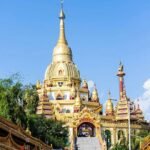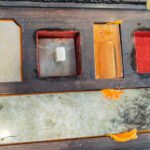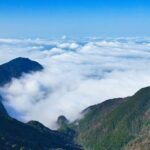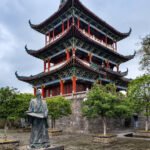The pagoda is located at the southern end of the Haiyin Pond, standing 18 meters high as a five-tiered square tower with a double-layered base and a triple-layered body, featuring platforms instead of eaves, entirely constructed from the beautiful stones of Taihu Lake.

The pagoda, dating back to the Yuan Dynasty during the Yuantong era, was rebuilt with funds raised by the monk Fu Zhong and supported financially by the Crown Prince Xuan Rangwang and other princes of the Jiangnan region. Adjacent to the pagoda, the Crown Prince’s Pagoda Courtyard was also built.
In 1919, Master Yin Guang, along with the abbots Liao Yu and Liao Qing, requested donations from the lay Buddhist Chen Xingliang to repair and restore the pagoda, resulting in its current form.
The top three tiers of the pagoda feature niches with Buddha sculptures on all four sides, each with a unique and elegant design. Particularly noteworthy are the thirty-two manifestations of Guanyin on the third tier, whose gentle and solemn expressions evoke a sense of warmth and dignity. The pagoda’s distinctive treasure-chest seal style is rare nationwide.
The backdrop of the Buddha statues is the eighteen Arhats, each with distinct expressions, vividly depicted. On each tier, stone platforms are adorned with stone railings, with the ends of the railing pillars carved with patterns of guardian deities, lions, and lotus flowers.
The base platform of the stone pagoda is relatively wide, with the top tier’s four corners decorated with banana leaves and mountain flowers. Four dragon heads are carved beneath the railings, open-mouthed as if spouting water. During rainy days, water flows from the dragon mouths, resembling dragons drooling.
At dawn, as the sun rises over the sea, standing within the pagoda courtyard and listening to the melodious bell sounds from the Puji Temple and the surging tide of the Baibu Sand Beach, the two sounds harmonize and resonate, invigorating the spirit and earning the pagoda the reputation of ‘Pagoda Bell Hearing’.
The pagoda courtyard also contains numerous historical relics and inscriptions. When Kang Youwei visited Putuo Mountain, he inscribed the words ‘First of Seas and Mountains’ on a rock within the courtyard. Inside the pagoda, a record titled ‘The Record of the Hidden Relics at the Bottom of the Crown Prince’s Pagoda on Putuo Mountain’, written by the inspector Fu Guangzhai of Liaocheng in the 17th year of the Wanli era (1589) and calligraphed by Yu Jinyang of Yuyao, was also discovered.
The opening hours and specific business status of the entire text are subject to the daily opening conditions.







